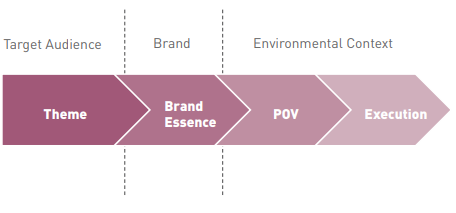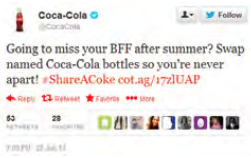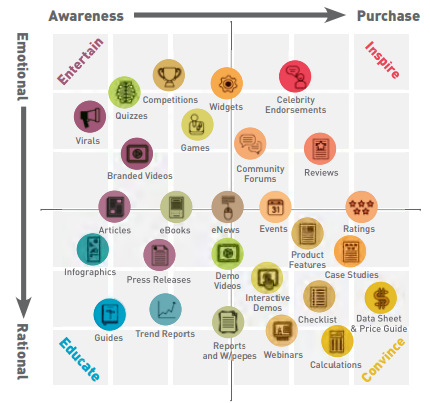15.4: Strategic building blocks
- Page ID
- 24952
Translating your brand essence
The brand essence sums up the unique attributes of a brand and the basis for its emotional connection with customers. Remember your emotional connection with your customer is the very things that differentiates your brand from your competitors. Your brand essence should assist in defining a tone of voice for your brand and the style in which it engages with its customers. The brand essence can be a useful guide for ensuring that the content you create (and your marketing activity) represents the brand appropriately. You can relate this to your brand story. What is your reason for being? How do you connect that with the interests of your customers? What is the value you add to your customers’ lives? Is it convenience, health, status?
Consider a brand like Mercedes Benz. Their essential product is transportation, but the brand offers so much more than that to its customers. For example, it provides a sense of safety and security, customers know they are driving a car with the latest safety technology. But the brand’s most powerful aspect is the sense of achievement and status that owning a Mercedes Benz provides. The value of the brand is less about the product itself and transporting passengers, and more about the feeling and status the customer gets by owning the product.
Will It Blend? is a video series by Blendtec which builds on this principle. Blendtec produce industrial blenders. Their value proposition is that they can blend anything, and their very popular videos demonstrate this.

Market research and consumer personas
The sweet spot for content marketing lies in an intercept between the marketing goals of a brand, the brand personality as it guides and differentiates that brand in the marketplace, and the consumer motivation for paying any attention to a brand at all. One device that is used in addressing consumer needs is the development of a consumer persona.
A persona is a profile that a writer creates to embody the aggregated characteristics of the target audience for whom he or she is writing. It helps to personalise the brand. Personas are based on the profile of users of your content. Creating a profile is all about considering the characteristics of your customers and their needs and desires. For example, a brand like Philadelphia Cream Cheese could have a couple of customer personas. A busy father, who works full time, but still wants to provide healthy and nutritious lunches for his family. Or a young female foodie, who wants to try new recipes she finds online from international celebrity chefs to impress her friends at dinner parties. Each of these would require slightly different approaches when developing content. Both would benefit from videos featuring recipes, but one would appreciate regular basic options for lunchboxes, and the other a celebrity endorsement or even a celebrity hosted video of finer and more elaborate meals.
It’s important to focus on the motivations of the persona that you may create, rather than exterior signifiers that lead to the creation of a stereotype. The persona assists you in segmenting and understanding your target market and is a framework through which you can guide any content that you create.
Creating content themes
Linked to the brand identity are certain themes or concepts. These are areas of focus that support the creation of content that match a consumer’s interest. These themes must be true to the brand essence, not focused directly on sales, and should also speak to the interests of the audience.

For Coca-Cola, for example, consumer interests filtered through the brand essence of ‘Coke brings joy’ could result in the following themes:
Friendship
Sharing is caring
Spreading smiles.
These themes are then used as the basis on which to develop content ideas.

In the above tweet, we can see how a particular content theme was translated into a question that is focused on relationships and family. It also encourages engagement from the audience by asking for their input.
Another example which demonstrates this is how Corona brought their brand essence to life through an interactive documentary. The essence of the brand is to live the extraordinary, and provide amazing experiences to its customers. The documentary depicted a group of people from Bulin in China, officially the town furthest away from any ocean in the world, encountering the ocean for the very first time. A truly extraordinary and amazing experience, facilitated by Corona. You can view it here: https://www.youtube.com/watch?v=V8ELAv3Ovho.
Matching content formats to objectives
Information can be presented through any number of mediums, which is both an opportunity and a challenge faced by content marketers. Traditional print distribution allows for magazines, pamphlets and even events. Digital distribution allows for videos, images, interactive infographics, GIFs, live photos, live video, cinemagraphs, and any number of other formats. To gain and keep the attention of consumers/users, it’s sometimes not enough to rely simply on text-based forms of content. The role of the content marketer is to select the right medium based on overall objectives, production capabilities, and the needs of the audience. Consider the illustration below.

As discussed in the Strategy and context chapter, determining your objectives is an essential part of your marketing planning, and should feed into your content marketing strategy, and ultimately the business strategy. Understanding the journey your consumers go through as they approach your ultimate sales goal will enable you to match content formats to their needs. A humorous video may be successful in initially making potential customers aware of your brand. However, once you have their attention, a research paper or useful case study could be more effective in convincing them that you are the best choice in the market.
Price Waterhouse Cooper (PWC) is one of the largest international financial consulting firms, offering a range of financial services and advice across the globe. Every year they publish valuable content and guides to assist their customers with tax and wealth management. You can find the 2017 guide here: www.pwc. com/us/en/private-company-services/publications/tax-wealth-managementguide.html
There are many examples of online journalism using multimedia to convey information most effectively to their users. The New York Times has presented a number of different methods for conveying complex information in an engaging manner. ‘Snow Fall’ by John Branch is one example: http://www.nytimes.com/ projects/2012/snow-fall/#/?part=tunnel-creek.

The New York Times also often publishes infographics that demonstrate this principle powerfully.
Because users consume content across multiple screens, multimedia is necessary to ensure you keep the audience engaged, and they do not get bored with your content. See this infographic on the importance of exploring different types of multimedia with content marketing: blog.marketingv2.com/the-impo...eting-strategy .
To take advantage of these various forms of content delivery, it is necessary to build the correct capabilities. But how do you determine what forms of content you need?
The content audit
Once you have established your marketing goals, your brand personality and a guiding understanding of who you are trying to reach, the content audit is a necessary but sometimes laborious next step. The content audit involves an audit of all the existing content supplied by the brand such as the website, white papers, articles, videos, and content shared on social media sites can all be considered.
An assessment can then be made of how well these pieces of content match the strategic needs of the brand, its audience, and the appropriateness to the chosen channel.
While you can either thoroughly immerse yourself in this process or attempt to get a more time-efficient overview, the goal is to map what is currently on offer versus what is needed to achieve the strategic objective. It is important not just to understand what you have and who accesses it, but also how it is currently organised, through which channels, and how often it is accessed by your audience.
Many practitioners suggest the use of a spreadsheet to achieve this. Content can be found to be either mismatched to the goals of the organisation, or spot on. Most importantly, you can establish what is missing. Are your customer needs being addressed? Where do the opportunities lie?


